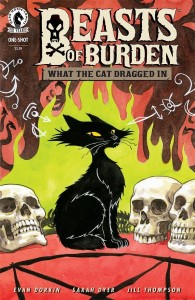 Beasts of Burden #1 (of 1) — Writer: Evan Dorkin and Sarah Dyer; Art/Colors: Jill Thompson
Beasts of Burden #1 (of 1) — Writer: Evan Dorkin and Sarah Dyer; Art/Colors: Jill Thompson
Alan Moore’s Cinema Purgatorio #1 — Creators: Various
Renato Jones: The One% #1 — Writer/Artist/Colorist: Kaare Andrews
Alpha King #1 (of 5) — Writers: Brian Azzarello and Nick Floyd; Art: Simon Bisley; Colors: Ryan Brown
4001 A.D. #1 — Writer: Matt Kindt; Art: Clayton Crain and David Mack
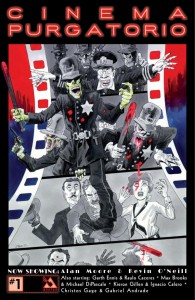 Weavers #1 (of 6) — Writer: Simon Spurrier; Art: Dylan Burnett; Colors: Triona Farrell
Weavers #1 (of 6) — Writer: Simon Spurrier; Art: Dylan Burnett; Colors: Triona Farrell
King’s Quest #1 (of 5) — Writers: Ben Acker and Heath Corson; Art: Dan McDaid; Colors: Omi Remalante
A bunch of cool indy first issues came out this week, so let’s start with them. A new Beasts of Burden is always cause for celebration, and this new one-shot, which focuses on the cats in its animal-ghostbusters crew, has the typical gorgeous art from Jill Thompson (look at that cover!) illustrating a demon/haunted house story from the husband-and-wife writing team of Dorkin and Dwyer. This builds on events in previous installments, but it isn’t necessary to have read them to enjoy it: if you’ve never encountered this series before,  get it, and be as charmed by its combination of horror, humor and pretty-darn-realistic animal characters as all of the rest of us. Cinema Purgatorio is a new anthology series, also horror, from Alan Moore and Kevin O’Neill; Moore and O’Neill supply the framing conceit, about a dreamlike, sinister movie house that shows off-kilter films: the first is a 1914-era silent film which veers quickly from the comic to the violent, the Keystone Kops as directed by Quentin Tarantino; other offerings include Code Pru, written by Garth Ennis and drawn by Raulo Caceres (and which introduced its supernatural-paramedic heroine concept and characters in a couple of solo comics before migrating here); Modded, by Kieron Gillen with art by Ignacio Calero, which mashes up demon invasions and Pokemon; A More Perfect Union, by Max Brooks with art by
get it, and be as charmed by its combination of horror, humor and pretty-darn-realistic animal characters as all of the rest of us. Cinema Purgatorio is a new anthology series, also horror, from Alan Moore and Kevin O’Neill; Moore and O’Neill supply the framing conceit, about a dreamlike, sinister movie house that shows off-kilter films: the first is a 1914-era silent film which veers quickly from the comic to the violent, the Keystone Kops as directed by Quentin Tarantino; other offerings include Code Pru, written by Garth Ennis and drawn by Raulo Caceres (and which introduced its supernatural-paramedic heroine concept and characters in a couple of solo comics before migrating here); Modded, by Kieron Gillen with art by Ignacio Calero, which mashes up demon invasions and Pokemon; A More Perfect Union, by Max Brooks with art by  Michael DiPascale, an alternate-history tale set during the Civil War; and The Vast, by Christos Gage with art by Gabriel Andrade, who gets to draw fighter pilots against huge mutated sea creatures. That’s an all-star lineup, and for $5.99, less than twice the price of a regular comic, it’s a bargain. Renato Jones: The One% is a solo effort from Kaare Andrews; the cover blurb, by Warren Ellis, calls it “a sort of hallucinatory rage-pop ‘Punisher from Occupy,'” and says it’s “gorgeous, and also demented.” Can’t improve on that: it’s one of those all-rich-people-are-scum conceits, with the title character avenging their treatment of all the rest of us by killing them in various ways. If you’ve encountered Andrews’s work before, you know to expect nice-looking, imaginatively-designed art over an energetic plot that makes no sense (the “demented” part of Ellis’s quote).; your
Michael DiPascale, an alternate-history tale set during the Civil War; and The Vast, by Christos Gage with art by Gabriel Andrade, who gets to draw fighter pilots against huge mutated sea creatures. That’s an all-star lineup, and for $5.99, less than twice the price of a regular comic, it’s a bargain. Renato Jones: The One% is a solo effort from Kaare Andrews; the cover blurb, by Warren Ellis, calls it “a sort of hallucinatory rage-pop ‘Punisher from Occupy,'” and says it’s “gorgeous, and also demented.” Can’t improve on that: it’s one of those all-rich-people-are-scum conceits, with the title character avenging their treatment of all the rest of us by killing them in various ways. If you’ve encountered Andrews’s work before, you know to expect nice-looking, imaginatively-designed art over an energetic plot that makes no sense (the “demented” part of Ellis’s quote).; your 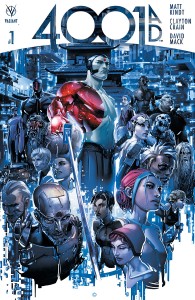 tolerance for the latter, versus your appreciation of the former, will determine whether you like this comic. Alpha King is about how us, and our reality, are actually a veneer for a much more barbaric universe — but never mind that; it’s really just an excuse to let Simon Bisley draw mutant demon bikers and barbarians hacking off heads and generally creating mayhem; if you just brightened up when you read that description, here’s your comic. 4001 A.D. kicks off a new crossover event from Valiant, and this first issue features a far-future version of the character Rai, and a Japan that’s actually a huge Earth-orbiting satellite, and is run by an A.I. tyrant, and so on: its attraction is the creative team, since writer Kindt is always entertaining and weird, and Crain has a dense, painterly style that’s good at handling elements like giant robots, or space-cities
tolerance for the latter, versus your appreciation of the former, will determine whether you like this comic. Alpha King is about how us, and our reality, are actually a veneer for a much more barbaric universe — but never mind that; it’s really just an excuse to let Simon Bisley draw mutant demon bikers and barbarians hacking off heads and generally creating mayhem; if you just brightened up when you read that description, here’s your comic. 4001 A.D. kicks off a new crossover event from Valiant, and this first issue features a far-future version of the character Rai, and a Japan that’s actually a huge Earth-orbiting satellite, and is run by an A.I. tyrant, and so on: its attraction is the creative team, since writer Kindt is always entertaining and weird, and Crain has a dense, painterly style that’s good at handling elements like giant robots, or space-cities 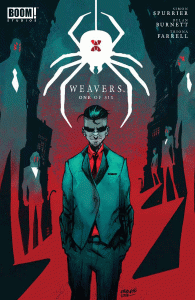 that turn into dragons. Weavers, by Simon Spurrier, starts out being about a new member of a drug gang, and whether he’s an informer or just inexperienced, but it quickly turns out that practically everyone has some kind of semi-demonic super-power, and the reasons for them turn out to be both intriguing and grotesque; Burnett’s art, and Farrell’s coloring, do a good job of delivering clear storytelling and a couple of decent shocks and violent action scenes, and it does its first-issue job of making readers want to pick up the second issue, too. That leaves King’s Quest, a mashup of most of the better-known King’s Features newspaper-strip adventure characters: Mandrake the Magician, Flash Gordon (and crew), Prince Valiant, and the Phantom. This is a continuation of a previous mini-series, so at least we’re spared the getting-the-band-
that turn into dragons. Weavers, by Simon Spurrier, starts out being about a new member of a drug gang, and whether he’s an informer or just inexperienced, but it quickly turns out that practically everyone has some kind of semi-demonic super-power, and the reasons for them turn out to be both intriguing and grotesque; Burnett’s art, and Farrell’s coloring, do a good job of delivering clear storytelling and a couple of decent shocks and violent action scenes, and it does its first-issue job of making readers want to pick up the second issue, too. That leaves King’s Quest, a mashup of most of the better-known King’s Features newspaper-strip adventure characters: Mandrake the Magician, Flash Gordon (and crew), Prince Valiant, and the Phantom. This is a continuation of a previous mini-series, so at least we’re spared the getting-the-band-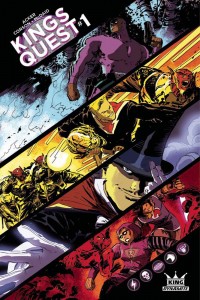 together stuff, but at this point it’s basically everybody-in-space, heading to fight… yes, Ming the Merciless. Artist McDaid has an expressionistic style that’s easy to like, and fluid enough to handle some nice sf-technology and alien-planet effects, but he’s got an impossible job, trying to render all those different characters with very different model sheets; his Prince Valiant is OK in action long-shots, but up close looks particularly goofy. Overall, if you’re a fan of these characters in their previous incarnations, this is probably worth checking out, but if you can’t immediately answer the question “Who’s Flash Gordon’s girlfriend?” then you won’t find much to recommend it.
together stuff, but at this point it’s basically everybody-in-space, heading to fight… yes, Ming the Merciless. Artist McDaid has an expressionistic style that’s easy to like, and fluid enough to handle some nice sf-technology and alien-planet effects, but he’s got an impossible job, trying to render all those different characters with very different model sheets; his Prince Valiant is OK in action long-shots, but up close looks particularly goofy. Overall, if you’re a fan of these characters in their previous incarnations, this is probably worth checking out, but if you can’t immediately answer the question “Who’s Flash Gordon’s girlfriend?” then you won’t find much to recommend it.
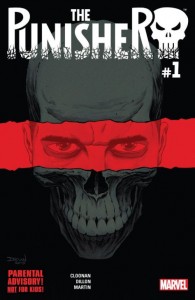 The Punisher #1 — Writer: Becky Cloonan; Art: Steve Dillon; Colors: Frank Martin
The Punisher #1 — Writer: Becky Cloonan; Art: Steve Dillon; Colors: Frank Martin
Daredevil/Punisher #1 (of 4) — Writer: Charles Soule; Layouts: Reilly Brown; Art: Szymon Kudranski; Colors: Jim Charalampidis
Thunderbolts #1 — Writer: Jim Zub; Art: Jon Malin; Colors: Matt Yackey
Gwenpool #0 — Writer: Christopher Hastings; Art/Colors: Danilo Beyruth and Tamra Bonvillain;  Gurihiru
Gurihiru
All the Marvel… well, I was going to say “debuts,” but none of them are actual new characters — and the first one, Punisher, is on something like its tenth volume with this “first” issue. It’s better than at least half of the earlier ones, too — Steve Dillon was born to draw the character, with his thin, clear line and knack for both ordinary people and bloody violence, and Becky Cloonan brings those elements nicely: not as well as Garth Ennis, but equal to Daniel Way, of the other two writers most associated with Dillon”s Frank Castle art. Daredevil/Punisher is a mini-series, the latest of several, 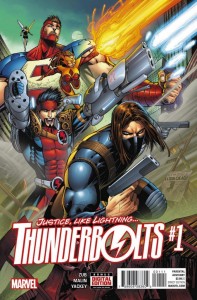 and obviously the second season of the TV series figured heavily in the calculations here. Soule’s a dependably-solid plotter, and this tale of DD trying to get an in-custody Russian mobster to an evac flight, as Castle tries to kill him, makes for a reasonably-engrossing chess match (chess with billy clubs and bullets, of course…). Thunderbolts offers the fourth volume of its group of semi-reformed criminals trying to be good guys, and springs from the events of the recently-concluded Standoff: Assault on Pleasant Hill; Bucky Barnes/Winter Soldier is the leader, and the team is mostly the original crew: Moonstone, Atlas, Mach-X and the Fixer, plus the little girl/sentient cosmic cube Kobik. Competent-but-standard fare, with a “shock”
and obviously the second season of the TV series figured heavily in the calculations here. Soule’s a dependably-solid plotter, and this tale of DD trying to get an in-custody Russian mobster to an evac flight, as Castle tries to kill him, makes for a reasonably-engrossing chess match (chess with billy clubs and bullets, of course…). Thunderbolts offers the fourth volume of its group of semi-reformed criminals trying to be good guys, and springs from the events of the recently-concluded Standoff: Assault on Pleasant Hill; Bucky Barnes/Winter Soldier is the leader, and the team is mostly the original crew: Moonstone, Atlas, Mach-X and the Fixer, plus the little girl/sentient cosmic cube Kobik. Competent-but-standard fare, with a “shock”  ending (but one that could be easily fixed in a panel or two of the next issue), and if you’ve enjoyed previous versions of the characters you should like this one. Gwenpool is a #0 issue, meaning that it’s reprinting her appearances before she got her own book: a trio of back-up stories in Howard the Duck #1-3, and a chapter in the Marvel Holiday Special (which was hastily retitled Gwenpool Holiday Special when Marvel realized how hot the no-relation-to-Wade-but-the-“pool” character had become). Those are all fairly recent and easy to get, but their combined cover prices are about $18, so the $4.99 here isn’t a bad deal if you want to see what all the fuss is about.
ending (but one that could be easily fixed in a panel or two of the next issue), and if you’ve enjoyed previous versions of the characters you should like this one. Gwenpool is a #0 issue, meaning that it’s reprinting her appearances before she got her own book: a trio of back-up stories in Howard the Duck #1-3, and a chapter in the Marvel Holiday Special (which was hastily retitled Gwenpool Holiday Special when Marvel realized how hot the no-relation-to-Wade-but-the-“pool” character had become). Those are all fairly recent and easy to get, but their combined cover prices are about $18, so the $4.99 here isn’t a bad deal if you want to see what all the fuss is about.
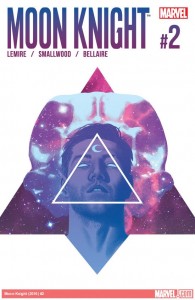 Moon Knight #2 — Writer: Jeff Lemire; Art: Greg Smallwood; Colors: Jordie Bellaire
Moon Knight #2 — Writer: Jeff Lemire; Art: Greg Smallwood; Colors: Jordie Bellaire
Black Widow #3 — Writer: Mark Waid; Art: Chris Samnee; Colors: Matthew Wilson
Invincible Iron Man #9 — Writer: Brian Michael Bendis; Art: Mike Deodato; Colors: Frank Martin
Scarlet Witch #6 — Writer: James Robinson; Art/Colors: Marguerite Sauvage
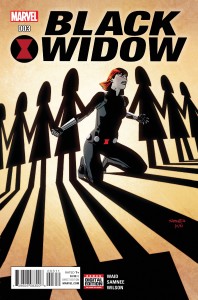 Amazing Spider-Man #12 — Writer: Dan Slott; Pencils: Giuseppe Camuncoli; Inks: Cam Smith; Colors: Marte Gracia
Amazing Spider-Man #12 — Writer: Dan Slott; Pencils: Giuseppe Camuncoli; Inks: Cam Smith; Colors: Marte Gracia
The rest of the Marvels — all of them decent, well-constructed examples of corporate superhero characters. Moon Knight, after its establish-the-premise insane-asylum first issue, ramps up the action nicely, establishes the high stakes involved, and gets Spector into the white suit from the Ennis/Shalvey run; it’s a quick, exciting read, with effective plotting and pacing from Lemire and 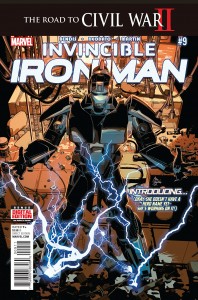 increasingly good-looking art from Smallwood, and should meet the company’s presumably-modest goals for a B-list character like this: twelve or eighteen issues, and two or three trades to add to their backlist. Black Widow was always a B-lister, too, but thanks to her movie appearances now has a higher profile, and a decidedly A-list creative team in Waid and Samnee; this first arc has been playing like a classic Bond movie — start with a slick high-octane chase, set up the premise, and stir in some flashbacks — and while things are murky here at the halfway point, they’ll no doubt all come together by the conclusion. Iron Man picks up a few weeks after the big Tokyo explosion that ended the last issue, with everyone
increasingly good-looking art from Smallwood, and should meet the company’s presumably-modest goals for a B-list character like this: twelve or eighteen issues, and two or three trades to add to their backlist. Black Widow was always a B-lister, too, but thanks to her movie appearances now has a higher profile, and a decidedly A-list creative team in Waid and Samnee; this first arc has been playing like a classic Bond movie — start with a slick high-octane chase, set up the premise, and stir in some flashbacks — and while things are murky here at the halfway point, they’ll no doubt all come together by the conclusion. Iron Man picks up a few weeks after the big Tokyo explosion that ended the last issue, with everyone 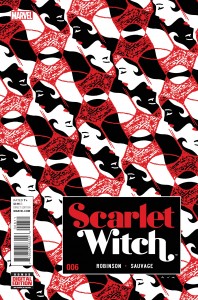 looking for a missing Tony Stark (including the still-helmetless and still-unscarred Doctor Doom, who quizzes Stark’s new biologist girlfriend about it), who turns up eventually — and unexpectedly. The issue’s mostly set-up, but, considering it’s delivered by Bendis/Deodato (another of Marvel’s top-tier creative teams), it’s a readable-enough chapter of the ongoing story. Scarlet Witch is a one-shot tale set in Paris, involving a winged hero there who’s haunted by his past, and Wanda’s attempts to help him; as every issue has done lately, it gives a new artist a chance to tackle the character: in this case, Marguerite Sauvage, whose dreamy, fashion-conscious illustrations prove a good fit. Robinson seems
looking for a missing Tony Stark (including the still-helmetless and still-unscarred Doctor Doom, who quizzes Stark’s new biologist girlfriend about it), who turns up eventually — and unexpectedly. The issue’s mostly set-up, but, considering it’s delivered by Bendis/Deodato (another of Marvel’s top-tier creative teams), it’s a readable-enough chapter of the ongoing story. Scarlet Witch is a one-shot tale set in Paris, involving a winged hero there who’s haunted by his past, and Wanda’s attempts to help him; as every issue has done lately, it gives a new artist a chance to tackle the character: in this case, Marguerite Sauvage, whose dreamy, fashion-conscious illustrations prove a good fit. Robinson seems  to be building a long-term plot here, brick by careful brick, and it’ll be interesting to see how it all plays out. Amazing Spider-Man‘s been doing that kind of world-building for years, and keeps it up in its own latest issue, as Mary Jane Watson arrives (with Tony Stark), the industrialist-hating, Occupy-sympathetic villain The Ghost shows up, and yet another bad guy — an imposing one, from one of the Secret Wars Spidey tie-ins — begins to make his presence felt. Camuncoli’s gotten very confident in drawing these characters over the last few years; there’s a two-panel reaction shot from Peter (in a scene where he tries to get back at Tony hiring Mary Jane by calling… well, read it and see) that’s just perfect.
to be building a long-term plot here, brick by careful brick, and it’ll be interesting to see how it all plays out. Amazing Spider-Man‘s been doing that kind of world-building for years, and keeps it up in its own latest issue, as Mary Jane Watson arrives (with Tony Stark), the industrialist-hating, Occupy-sympathetic villain The Ghost shows up, and yet another bad guy — an imposing one, from one of the Secret Wars Spidey tie-ins — begins to make his presence felt. Camuncoli’s gotten very confident in drawing these characters over the last few years; there’s a two-panel reaction shot from Peter (in a scene where he tries to get back at Tony hiring Mary Jane by calling… well, read it and see) that’s just perfect.
 Green Arrow #52 — Writer: Benjamin Percy; Art: Szymon Kudranski; Colors: Gabe Eltaeb
Green Arrow #52 — Writer: Benjamin Percy; Art: Szymon Kudranski; Colors: Gabe Eltaeb
Green Lantern #52 — Writer: Robert Venditti; Pencils: Billy Tan; Innks: Mark Irwin and Livesay; Colors: Alex Sinclair
The Coming of the Supermen #4 (of 6) — Writer/Artist: Neal Adams; Inks: Buzz and Josh Adams; Colors: Tony Avina
We’re starting to see the 52nd issues of the original “New 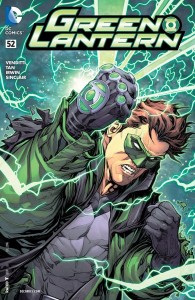 52″ books — their last ones, with the “Rebirth” revamp of the line looming in a month — so everything’s getting wrapped up and prepositioned for whatever the next reincarnation brings. Green Arrow, for example, has been enmeshed in a lycanthropic-biker story, and it gets wrapped up here, with its hero reinvigorated and only a few loose ends left dangling. Green Lantern has no Green Lanterns left in the universe — that anyone knows of, but of course if you’re a DC comics reader you know that isn’t quite true, thanks to the Green Lantern Corps: Edge of Oblivion mini-series — but it has a Hal Jordan who’s
52″ books — their last ones, with the “Rebirth” revamp of the line looming in a month — so everything’s getting wrapped up and prepositioned for whatever the next reincarnation brings. Green Arrow, for example, has been enmeshed in a lycanthropic-biker story, and it gets wrapped up here, with its hero reinvigorated and only a few loose ends left dangling. Green Lantern has no Green Lanterns left in the universe — that anyone knows of, but of course if you’re a DC comics reader you know that isn’t quite true, thanks to the Green Lantern Corps: Edge of Oblivion mini-series — but it has a Hal Jordan who’s 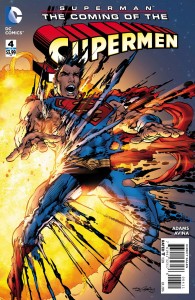 becoming a living embodiment of the power battery force, and just knowing that his next appearance will be in a comic called Hal Jordan and the Green Lantern Corps: Rebirth #1 should give you a good idea of where everything’s going. The Coming of the Supermen is a Neal Adams mini-series, so it’s using the “classic” Superman and a trio of Kryptonians vs. Darkseid and company; Adams, at this stage of his long career, does pretty much whatever he wants, so it has no connection to “New 52,” “Rebirth” or any other story outside of the Adams-verse, a place with old-school Silver-Age sensibilities, sometimes-weird dialogue tics, and lush, undeniably-high-quality art.
becoming a living embodiment of the power battery force, and just knowing that his next appearance will be in a comic called Hal Jordan and the Green Lantern Corps: Rebirth #1 should give you a good idea of where everything’s going. The Coming of the Supermen is a Neal Adams mini-series, so it’s using the “classic” Superman and a trio of Kryptonians vs. Darkseid and company; Adams, at this stage of his long career, does pretty much whatever he wants, so it has no connection to “New 52,” “Rebirth” or any other story outside of the Adams-verse, a place with old-school Silver-Age sensibilities, sometimes-weird dialogue tics, and lush, undeniably-high-quality art.
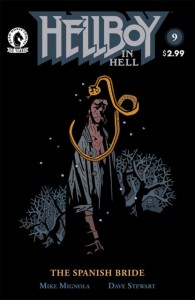 Hellboy in Hell #9 — Writer/Artist: Mike Mignola; Colors: Dave Stewart
Hellboy in Hell #9 — Writer/Artist: Mike Mignola; Colors: Dave Stewart
Empress #2 (of 7) — Writer: Mark Millar; Pencils: Stuart Immonen; Inks: Wade von Grawbadger; Colors: Ive Svorcina
War Stories #18 — Writer: Garth Ennis; Art: Tomas Aira; Colors: Digikore Studios
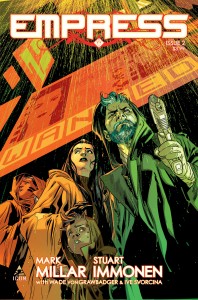 The Wicked and the Divine #19 — Writer: Kieron Gillen; Art: Jamie McKelvie; Colors: Matthew Wilson
The Wicked and the Divine #19 — Writer: Kieron Gillen; Art: Jamie McKelvie; Colors: Matthew Wilson
The best of the non-first-issue indies: Hellboy is Mignola-drawn, and at this stage of his career his line is as pure as a Moebius, every mark in service to his surreal, fairytale horror; you could look at those inky-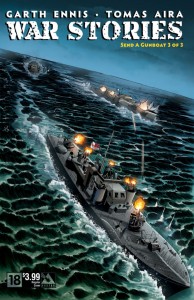 black panels (and Dave Stewart’s coloring) all night. Empress is Flash Gordon-y space opera from Millar; it would dearly love to be Saga — and Immonen gets off at least one splash worthy of Fiona Staples — but the story never does anything quite as unexpected (until the literal cliffhanger at the end), and the characters have yet to come alive on the page. War Stories ends one of its typical three-part stories, about British and German gunboats playing tag off the British coast during World War II, in its typically-polished and world-weary fashion; it’s easy to take for granted, but it’s the only war comic out there, the last
black panels (and Dave Stewart’s coloring) all night. Empress is Flash Gordon-y space opera from Millar; it would dearly love to be Saga — and Immonen gets off at least one splash worthy of Fiona Staples — but the story never does anything quite as unexpected (until the literal cliffhanger at the end), and the characters have yet to come alive on the page. War Stories ends one of its typical three-part stories, about British and German gunboats playing tag off the British coast during World War II, in its typically-polished and world-weary fashion; it’s easy to take for granted, but it’s the only war comic out there, the last 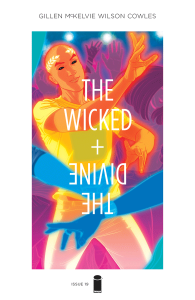 remnant of a once-dominant genre, and it upholds the traditions with careful research and dependable quality. The Wicked and the Divine is Gillen and McKelvie, a team always worth following, and especially so now that it’s opened up its fourth volume of this pop-culture-fueled tale of perpetually-reincarnated gods in earnest, with the (apparent?) return of a beloved character, and all-out war among the doomed avatars who make up its pantheon. This issue offers a taste of its quick, razor-sharp charms; readers who like it can look forward to getting caught up via the three earlier trade collections.
remnant of a once-dominant genre, and it upholds the traditions with careful research and dependable quality. The Wicked and the Divine is Gillen and McKelvie, a team always worth following, and especially so now that it’s opened up its fourth volume of this pop-culture-fueled tale of perpetually-reincarnated gods in earnest, with the (apparent?) return of a beloved character, and all-out war among the doomed avatars who make up its pantheon. This issue offers a taste of its quick, razor-sharp charms; readers who like it can look forward to getting caught up via the three earlier trade collections.



